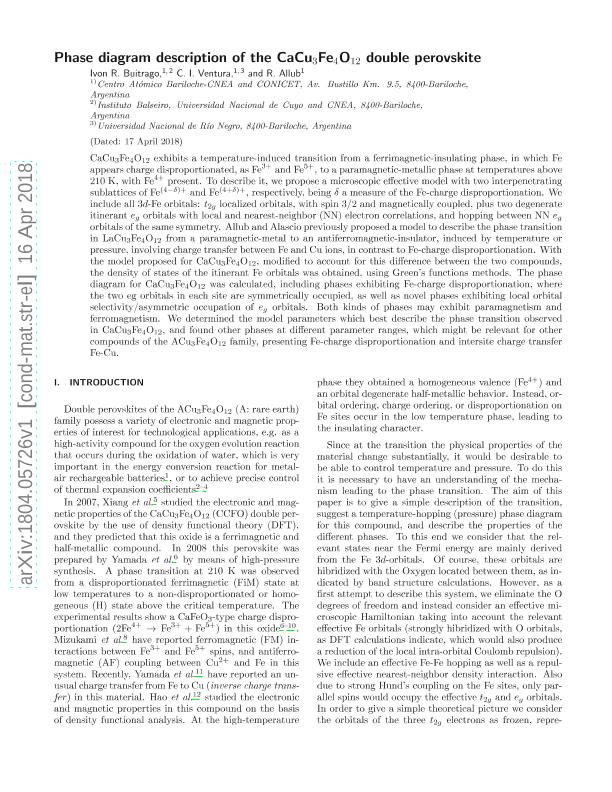Mostrar el registro sencillo del ítem
dc.contributor.author
Buitrago Piñeros, Ivon Rocio

dc.contributor.author
Ventura, Cecilia Ileana

dc.contributor.author
Allub, Roberto Jose

dc.date.available
2021-07-28T12:58:25Z
dc.date.issued
2018-07
dc.identifier.citation
Buitrago Piñeros, Ivon Rocio; Ventura, Cecilia Ileana; Allub, Roberto Jose; Phase diagram description of the CaCu3Fe4O12 double perovskite; American Institute of Physics; Journal of Applied Physics; 124; 4; 7-2018; 1-11
dc.identifier.issn
0021-8979
dc.identifier.uri
http://hdl.handle.net/11336/137172
dc.description.abstract
CaCu3Fe4O12 exhibits a temperature-induced transition from a ferrimagnetic-insulating phase, in which Fe appears charge disproportionated, as Fe 3 + and Fe 5 +, to a paramagnetic-metallic phase at temperatures above 210 K, with Fe 4 + present. To describe it, we propose a microscopic effective model with two interpenetrating sublattices of Fe (4 - δ) + + and Fe (4 + δ) + +, respectively, δ being a measure of the Fe-charge disproportionation. We include all 3d-Fe orbitals: t 2 g localized orbitals, with spin 3/2 and magnetically coupled, plus two degenerate itinerant eg orbitals with local and nearest-neighbor (NN) electron correlations, and hopping between NN eg orbitals of the same symmetry. Allub and Alascio [J. Phys.: Condens. Matter 24(49), 495601 (2012)] previously proposed a model to describe the phase transition in LaCu3Fe4O12 from a paramagnetic-metal to an antiferromagnetic-insulator, induced by temperature or pressure, involving charge transfer between Fe and Cu ions, in contrast to Fe-charge disproportionation. With the model proposed for CaCu3Fe4O12, modified to account for this difference between the two compounds, the density of states of the itinerant Fe orbitals was obtained, using Green´s function methods. The phase diagram of CaCu3Fe4O12 was calculated, including phases exhibiting Fe-charge disproportionation, where the two eg orbitals in each site are symmetrically occupied, as well as novel phases exhibiting local orbital selectivity/asymmetric occupation of eg orbitals. Both kinds of phases may exhibit paramagnetism and ferromagnetism. We determined the model parameters which best describe the phase transition observed in CaCu3Fe4O12 and found other phases in different parameter ranges, which might be relevant for other compounds of the ACu3Fe4O12 family, presenting Fe-charge disproportionation and intersite charge transfer Fe-Cu.
dc.format
application/pdf
dc.language.iso
eng
dc.publisher
American Institute of Physics

dc.rights
info:eu-repo/semantics/openAccess
dc.rights.uri
https://creativecommons.org/licenses/by/2.5/ar/
dc.subject
Electronic properties of transition metal oxides
dc.subject.classification
Física de los Materiales Condensados

dc.subject.classification
Ciencias Físicas

dc.subject.classification
CIENCIAS NATURALES Y EXACTAS

dc.title
Phase diagram description of the CaCu3Fe4O12 double perovskite
dc.type
info:eu-repo/semantics/article
dc.type
info:ar-repo/semantics/artículo
dc.type
info:eu-repo/semantics/publishedVersion
dc.date.updated
2019-10-15T17:57:48Z
dc.journal.volume
124
dc.journal.number
4
dc.journal.pagination
1-11
dc.journal.pais
Estados Unidos

dc.journal.ciudad
College Park
dc.description.fil
Fil: Buitrago Piñeros, Ivon Rocio. Consejo Nacional de Investigaciones Científicas y Técnicas. Centro Científico Tecnológico Conicet - Patagonia Norte; Argentina. Universidad Nacional de Cuyo; Argentina. Comisión Nacional de Energía Atómica. Gerencia del Área de Energía Nuclear. Instituto Balseiro; Argentina. Comisión Nacional de Energía Atómica. Centro Atómico Bariloche; Argentina
dc.description.fil
Fil: Ventura, Cecilia Ileana. Consejo Nacional de Investigaciones Científicas y Técnicas. Centro Científico Tecnológico Conicet - Patagonia Norte; Argentina. Comisión Nacional de Energía Atómica. Centro Atómico Bariloche; Argentina. Universidad Nacional de Río Negro; Argentina
dc.description.fil
Fil: Allub, Roberto Jose. Consejo Nacional de Investigaciones Científicas y Técnicas. Centro Científico Tecnológico Conicet - Patagonia Norte; Argentina. Comisión Nacional de Energía Atómica. Centro Atómico Bariloche; Argentina
dc.journal.title
Journal of Applied Physics

dc.relation.alternativeid
info:eu-repo/semantics/altIdentifier/doi/http://dx.doi.org/10.1063/1.5032206
dc.relation.alternativeid
info:eu-repo/semantics/altIdentifier/url/https://aip.scitation.org/doi/10.1063/1.5032206
Archivos asociados
